8 Benchmarks To Improve Your Live Chat Metrics
A live chat system gives customers direct access to help and service, wherever they are. Another bonus: Customers can multitask while waiting for an agent’s response. The same can be said for live chat agents, who can search and gather supporting information during a responsive live chat session with a customer without having to put them on hold.
This omnichannel approach also can improve customer satisfaction (CSAT) with live contact center chat services. In recent reports, live chat had a 79% impact on sales, revenue, and customer loyalty.
Some companies almost exclusively rely on a contact center live chat solution. Unity 3D, a technology and gaming company, started with just email, but has a live chat platform bypassing a traditional call center.
“When I started five years ago we didn’t even have a web form like it was literally just email,” said Angie Cantwell, Head of Customer Service at Unity. “We’ve come a long way and you kind of have to go with what the users want and what they want is the support that is as instant and helpful as possible.”
In live chat metrics, success is driven by agents who are friendly, responsive, and getting the job done for the customer. But what are the key live chat metrics in live chat quality assurance?
Here are eight important live chat performance benchmarks for evaluating a live chat agent’s performance — and how to improve chat quality:
1. First Response Time
Chat response time is critical and it’s important that a customer doesn’t spend any longer than a minute waiting for a response. This is one of the live chat performance benchmarks that just can’t be ignored.
Research by dialogtech.com says 59% of customers are more likely to buy a product if a company responds in less than a minute by phone. Chat solution metrics are immediate so inevitably, the numbers go up.
A strong first response time for live chat ensures customers receive responses within an acceptable time. Agents should be armed with canned responses to answer the most commonly asked customer questions in order to improve overall response time, chat performance, and chat service level standards.
A company should also route the live chats to the right agent across various departments, ensuring faster response delivery. This is a valuable metric for live chat providers since it sets the tone for other KPIs, including resolution, average handle time, and quantity of calls.
- Calculating Live Chat Metric: Average response time = Total time taken to respond during the selected time period divided by the number of responses in the selected time period.
- Live Chat Performance Benchmark: 80% of chats are answered within 40 seconds. (Source: Call Centre Helper.)
- First Response Time: 40 seconds

2. First Contact Resolution (FCR)
First Contact Resolution (FCR) measures what percent of the time agents solve customers’ issues in a live chat session. A high FCR rate leads to a high customer satisfaction rate too.
Resolving contact in a single interaction — whether it’s live chat, a phone call, an email exchange, etc. — ensures customers receive the support they need in a way that’s efficient and quick. This means a more convenient, less-stressful experience, with no need to arrange a callback or wait for further assistance.
In addition to a great customer experience, a strong FCR is good news for agents too. The more efficiently they handle an interaction, the more quickly they can move onto the next customer and maximize their workflow. It’s one more way to measure if your team is meeting chat service level standards.
Making First Contact Resolution a priority for live chat metrics will avoid repeat customers and allow the flow to remain efficient.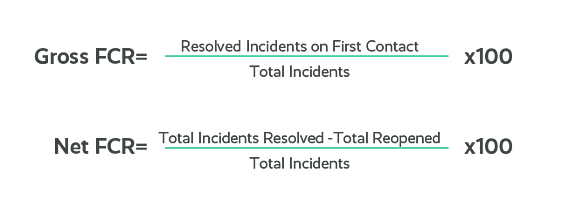
- Calculating Live Chat Metric: For gross FCR: Number of contacts resolved initially ÷ All incoming contacts. For net FCR: Number of contacts resolved initially ÷
(All incoming contacts – Contacts that cannot be resolved at level one) - Live Chat Performance Benchmark: The industry standard is between 70 and 75% for FCR. (Source: Call Centre Helper.)
3. Average Handle Time (AHT)
Average Handle Time (AHT) is a key performance metric regardless of the channel, whether it be live chat or phone. Staying on a call center chat, despite the immediate response rate, can take an average of 10 minutes. Of course, the total duration of the chat response time depends on the industry, the complexity of the customer’s concern, and the skills of the agent.
Measuring an agent’s AHT can enforce a quick and compact answer to any customer’s issues. A low AHT can be an indicator of a few things. On one hand, a low average handle time can mean an agent has a strong skill set and is a true pro at handling customers with both care and efficiency! But on the other hand, a low AHT could mean the agent is rushing through a chat and not giving customers the attention they deserve in solving the issue . . . or, even worse, leaving problems unsolved. So if you have a hunch it’s the latter that’s causing a low AHT chat metric, some training may be in order for how to improve chat quality.
- Calculating Live Chat Metric: Take the total amount of minutes talking to customers and add to the follow-up minutes and divide that by the number of chats.
- Live Chat Performance Benchmark: Average chat time is 10 minutes. (Source: The Chat Shop.)
4. Agent Utilization Rate
The agent utilization rate may be one of the more “under-the-radar” live chat metrics, but valuable nonetheless. Also sometimes called Agent Occupancy, this live chat performance benchmark measures how work time is being used.
This KPI reveals the percentage of time that chat agents are spending in live chats, wrap-up, and other productive functions, as opposed to in “away” mode or offline. Agent Utilization Rate, as a live chat metric, can help you determine both how efficient your contact center is as a whole and how each agent is performing.
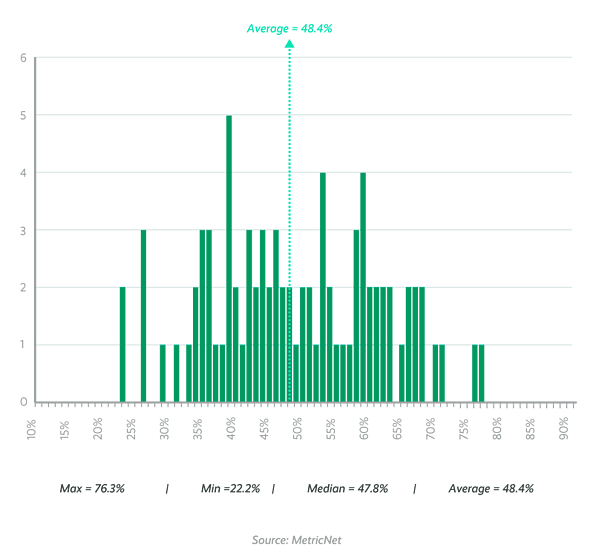
- Calculating Live Chat Metric: Take the average number of calls handled by an agent in a month and multiply it by average call handle time in minutes. That number is divided by the average number of days worked in a month multiplied by the number of hours worked in a day.
- Live Chat Performance Benchmark: MetricNet’s benchmarking database shows the average agent utilization for service desks worldwide is about 48 percent. (Source: MetricNet.)
5. Number of Live Chats
The total number of contact center chats per day is one of the live chat metrics that coincide with Average Handle Time and the Agent Utilization rate.
Tracking the number of live chats is an important live chat metric in measuring an agent’s performance numbers and is critical in the evaluation process. It’s crucial to monitor the total number of live chats to find out how many chats were assigned to the live chat agents, how many chats have been resolved, and how many are still pending.
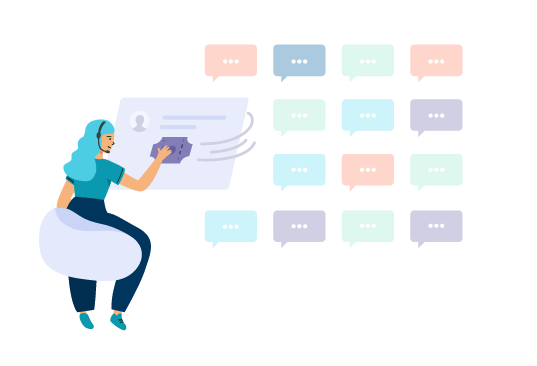
- Live Chat Performance Benchmark: The standard guideline for live chats is 274 chats per agent per month, which averages 13.7 per day. (Source: Acquire.io)
6. Customer Satisfaction (CSAT)
Of course, CSAT is a mainstay when it comes to contact center metrics for all communication channels. Typically, these scores are determined through customer surveys.
The agent should always encourage customers to share their experience through your post-communication survey. By having live chat agents promote a customer survey, you will receive consistent feedback and ensure chat service level standards are being met. If agents don’t encourage a customer to take the survey, it could lead to an unbalanced score where only customers who have a great experience — or worse, a bad experience — complete the survey.
If some live chat agents are generating high satisfaction levels, then it’s a big positive for the company. If others are not, then maybe it’s time for them to receive additional training or coaching.
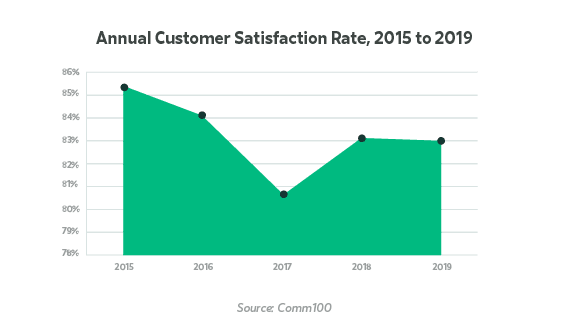
- Calculating Live Chat Metric: CSAT score is the average score of satisfied responses (the metric focuses on the two highest values) that indicates the number of clients willing to continue doing business with a particular company.
- Live Chat Performance Benchmark: The average score between 2015 and 2019 is between 81 and 87%. (Source: Comm100.)
7. Net Promoter Score (NPS)
NPS may seem similar to CSAT, but it’s a bit different: NPS measures the loyalty between customers and the company.
NPS delivers quick feedback and usually is an index on a 0 to 10 scale, in which customers rank how likely they would be to recommend a company to others. NPS eliminates doubts about your organization by asking one simple question. This is one of the live chat metrics that directly impact your reputation, and can have a ripple effect on the company’s health as a whole.
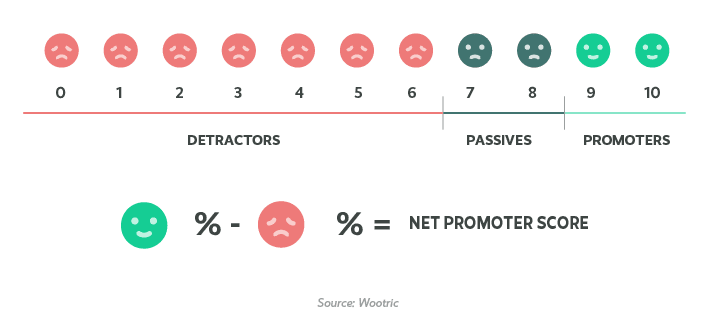
- Calculating Live Chat Metric: To calculate NPS and using a 0-10 score, organize responses into Detractors (0-6), Passives (7-8), and Promoters (9-10). Then, subtract the percentage of Detractors from the percentage of Promoters to determine your overall Net Promoter Score.
- Live Chat Performance Benchmark: It depends and varies for each industry, but a plus-50% promoters over detractors is a solid live chat score. (Source: Wootric.)
8. Quantity of Live Chats
This live chat metric is crucial for team leaders to monitor. Because it’s more impactful for the contact center as a whole than individual agents, keeping tabs on the number of live chats a department receives can help understand the flow of the support system along with the overall load.
This metric is key in planning staffing needs as well. It’s a balancing act. Contact center leaders need to both avoid overstaffing and ensure enough agents are available during peak live chat time frames.
Quantity of Live Chats can tell you during which days of the week and times of the day you can expect a surge in live chat volume. This will help you efficiently allocate agents and resources to handle peak times.
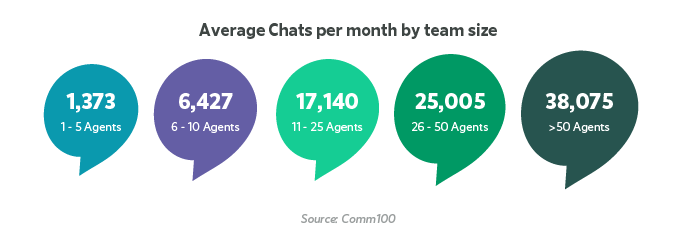
- Calculating Live Chat Metric: Take the number of website visitors per day divided by the percentage of visitors requesting chats and the abandonment rate percentage. For example, 7,000 website visitors per day with 20% requesting chats and 80% abandonment rate would amount to 1,400 chat requests per day with a live chat volume of 280 per day.
- Live Chat Performance Benchmark: This depends on the size of the company’s live chat center. A company with 6-10 agents averages 6,427 live chats per month. One with more than 50 agents averages 38,075 per month. (Source: Comm100.)
Conclusion
There are a number of live chat benchmarks a business can build to measure agent performance and ensure chat service level standards are met.
Monitoring the performance of agents who chat with customers can be different from those who receive calls. Live chat agents need to have a quicker response time, and it’s important for those agents to take care of the customer’s questions immediately and not transfer them to another department. It’s all about creating that great customer experience, from start to finish.
If you’re looking to centralize your KPIs in one place and create dashboards to share with your teams and agents, Playvox could be the solution that fits your needs. Request a demo today!
Did we leave a Live Chat Metric out? Tell us about your go-to Live Chat Quality Assurance KPIs in the comments section below.








